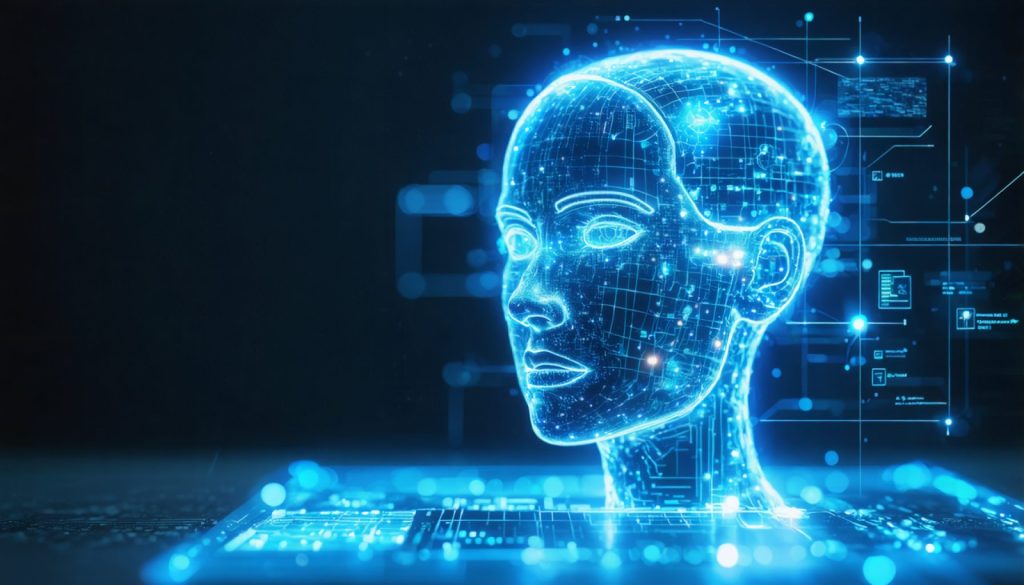
- Satya Nadella revealed that AI creates nearly 30% of Microsoft’s code, signaling a major shift in software development.
- AI’s role in tech companies is expanding, with Microsoft and Meta leading in integrating AI into their development processes.
- Meta’s CEO Mark Zuckerberg predicts AI could drive half of their code development within a year, aligning with Microsoft’s trajectory.
- Other tech giants like Google and Shopify are also adopting AI, emphasizing algorithmic efficiency over human expansion.
- Nadella highlighted AI’s potential beyond coding, suggesting software flexibility can counter economic challenges effectively.
- The technology sector is experiencing a shift, with AI evolving from a support tool to a key collaborator in innovation.
- This advancement marks the beginning of a new era, wherein AI becomes essential in tech innovation and strategic growth.
Under the dazzling lights of the stage, Microsoft’s CEO Satya Nadella painted a vivid picture of a quietly evolving frontier in technology. His declaration that nearly 30% of Microsoft’s code is authored by artificial intelligence ignites a profound dialogue about the future of software development. Imagine, if you will, lines of code not crafted painstakingly by human hands, but conjured by the silent logic of algorithms. This isn’t the plot of a futuristic novel; it’s our reality, one where technology ceases to merely assist and starts creating independently.
Nadella’s revelation, made in a lively conversation with Meta’s CEO, Mark Zuckerberg, signals a seismic shift in how we think about software creation. This isn’t just a quirky statistic; it’s a glimpse into the expanding role of AI in technology companies with massive global reach. Nadella emphasized a trajectory that promises only to climb steeper—AI’s contribution to Microsoft’s codebase is set to burgeon, painting a future where machines might soon be the primary authors of their own language.
As the two tech giants conversed, Zuckerberg, momentarily caught off guard, didn’t have numbers at the ready about Meta’s own AI code contributions. Yet, he disclosed a bold vision that mirrors Microsoft’s trajectory. Within a year, he speculates, AI might spearhead half of their development efforts, progressively minimizing human coding.
This digital symphony, however, isn’t sung by Microsoft and Meta alone. Others in Silicon Valley are echoing similar tunes. Google CEO Sundar Pichai has openly stated that over a quarter of the new code is shaped by AI—a nod to the increasing integration of automation in tech behemoths’ workflows. Shopify’s Tobi Lütke challenged employees to first seek AI solutions before calling in more human reinforcements, embodying a philosophy that favors algorithmic efficiency over human expansion. Even Duolingo stakes a claim in this evolution, with CEO Luis von Ahn highlighting a pivot toward AI and away from human-powered translations over time.
In the midst of this technological surge, Nadella offered insights into AI’s potential beyond mere code. Addressing tariff pressures stemming from global economic policies, he championed the flexibility and power of software over reliance on physical hardware. This perspective isn’t just prudent; it’s transformative. By leveraging AI and software, industries can strategize against economic headwinds, doing more with less and driving growth in innovative, resourceful ways.
The takeaway from these insights is unmistakably bright, if not slightly awe-inspiring: AI is transitioning from a tool to a collaborator. As technology companies lean in, transforming code and policy alike, we stand at the brink of a new era where artificial intelligence is not simply a support system, but a foundational storyteller of innovation. Time will tell just how much further AI can go, but for now, it’s clear that the dawn of this digital revolution is already casting its light across the horizon.
Revolutionizing Software Development: How AI is Transforming the Tech Landscape
Additional Insights on AI’s Role in Software Development
The landscape of software development is undergoing a tectonic shift, spearheaded by artificial intelligence. The revelation by Microsoft’s CEO Satya Nadella that nearly 30% of Microsoft’s code is written by AI underscores a pivotal change in how technology companies approach creation and innovation. But what does this mean for the industry as a whole?
How AI is Reshaping Software Development
1. Efficiency and Speed: AI-driven code generation significantly reduces the time spent on mundane tasks such as debugging, optimizing, and repetitive code writing. This accelerates the development process and allows human developers to focus on more complex and creative problem-solving tasks.
2. Quality and Consistency: Machine learning algorithms can consistently apply best practices and coding standards, leading to higher quality software with fewer bugs. This ensures a uniform development process and reduces the need for extensive code reviews.
3. Innovation in Design: AI not only automates existing processes but also introduces new paradigms in software design. It facilitates the development of complex systems like neural networks that require intricate and dynamic configurations.
Market Forecasts & Industry Trends
– Market Expansion: The global AI software market is expected to grow from $35.2 billion in 2021 to over $126 billion by 2025, according to Statista. This growth is propelled by the increasing adoption of AI-driven solutions across industries.
– Job Evolution: While AI handles more coding tasks, there is a shift in job roles. Developers are moving towards more strategic positions like AI trainers, ethicists, and integrators.
– Collaborative Tools: The future is leaning toward tools that allow seamless collaboration between AI and human developers. For example, GitHub Copilot uses machine learning to assist in code suggestion and completion.
Controversies & Limitations
– Dependence on AI: As AI becomes more integral to the software development process, there are concerns about over-reliance. There’s a risk of losing deep technical expertise among developers as AI undertakes more coding tasks.
– Security Concerns: AI-generated code is not immune to vulnerabilities. There’s an ongoing debate about the responsibility for code penned by AI, especially in security-critical applications.
– Ethical Considerations: How much control should AI have in software development? Ensuring ethical AI use and preventing bias in AI-generated code are significant challenges.
Quick Tips for Embracing AI in Software Development
1. Start Small: Begin by integrating AI for specific tasks like automated testing or bug fixing to familiarize your team with AI tools.
2. Continuous Learning: Encourage development teams to upskill in AI and machine learning. This ensures they stay relevant and can effectively collaborate with AI systems.
3. Ethical Guidelines: Establish a framework for ethical AI usage. Consider the implications of AI-driven decisions and their impact on society and your product’s end-users.
Actionable Recommendations
– Embrace AI as a tool for enhancing productivity rather than replacing human ingenuity.
– Invest in AI training programs to equip developers with the necessary skills to thrive alongside AI technologies.
– Leverage AI insights to predict future market trends and adapt swiftly to changes.
For more on integrating AI into your business strategies, visit Microsoft and explore their comprehensive AI solutions.



